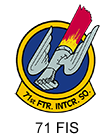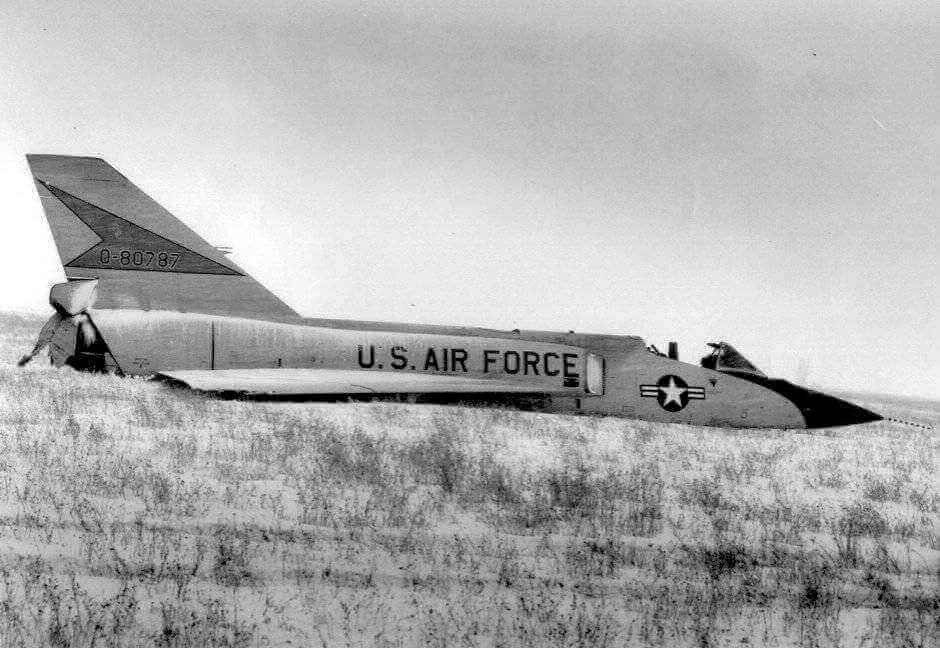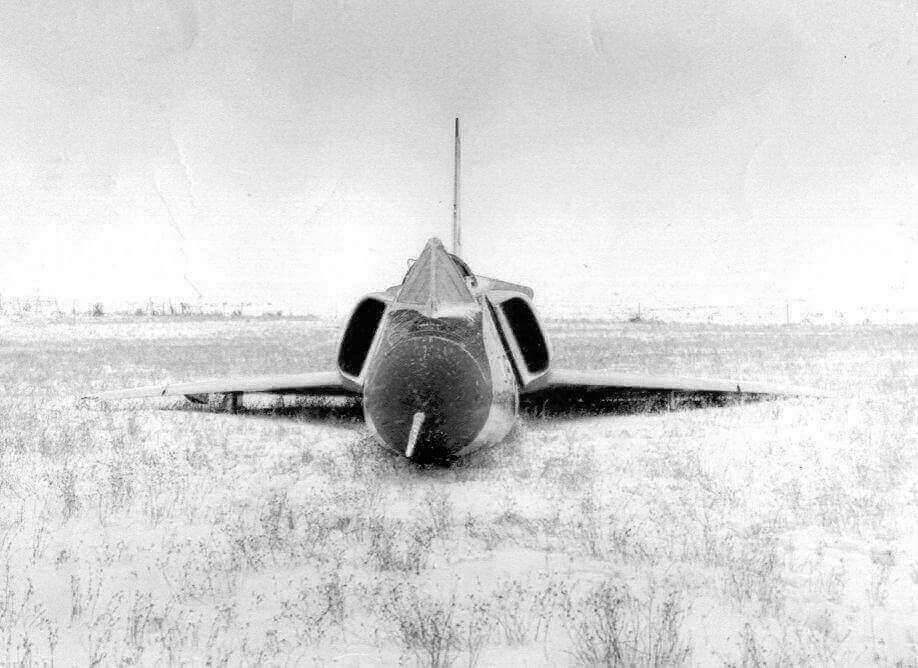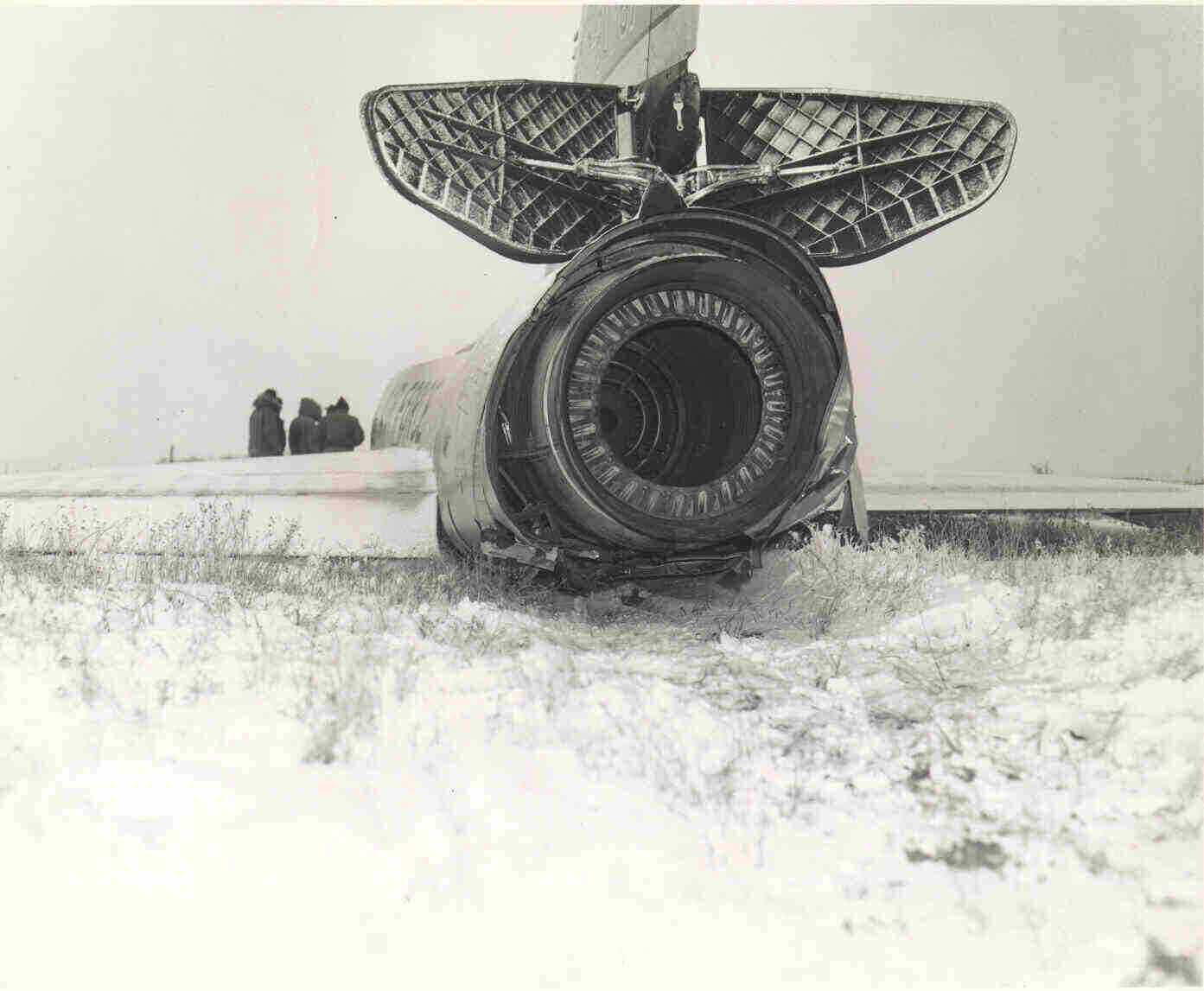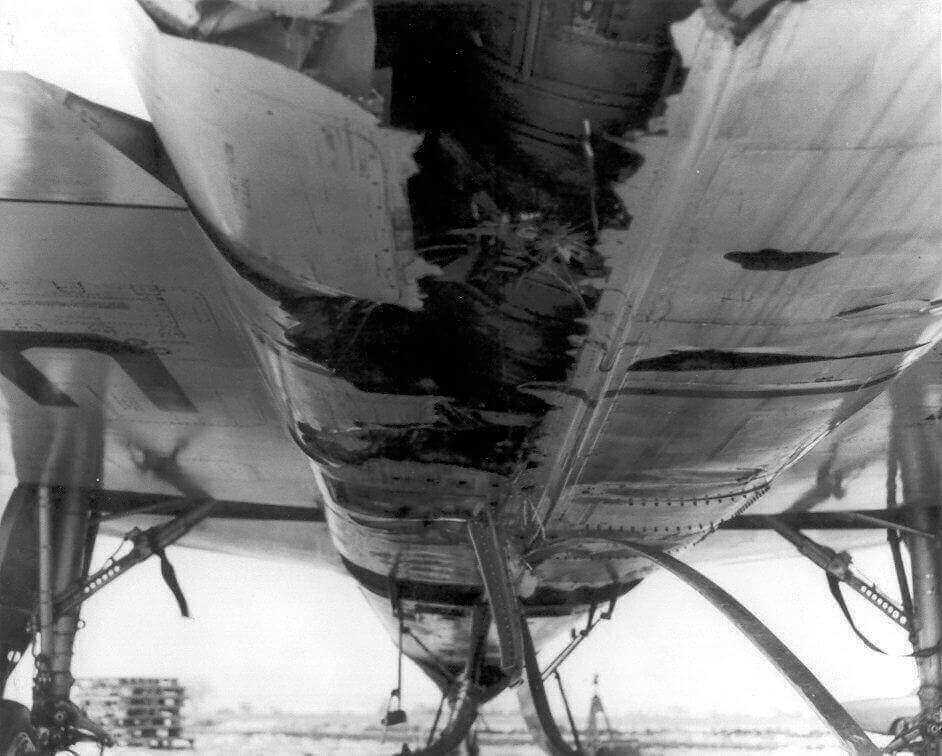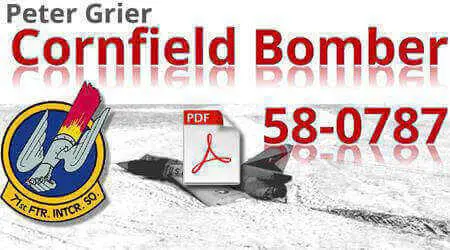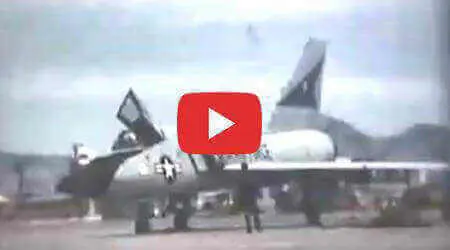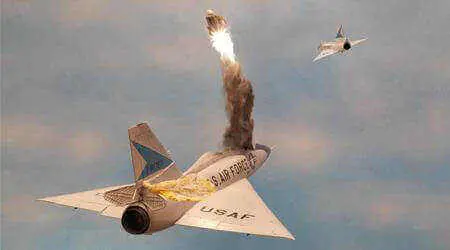The Story of 58-0787 on that day
That day started with a slightly non-routine 71st FIS three-ship training flight out of Malmstrom AFB into clear but frigid Montana skies. It was originally scheduled as a two-on-two air combat maneuvering session, but the fourth ship had to abort when its drag chute popped on the ramp, so mission changed to a two-versus-one session.
Radar vectored, two of the F-106s turned head-to-head toward the third from 20 miles away. When they passed each other at speed the fight was on. Instructor pilot Captain Tom Curtis, in the solo aggressor slot, described it.
“I figured I could handle [1st Lt.] Gary [Foust, in 58-0787] pretty easy, but I did not trust Jimmy [IP Pilot Major James ‘Jim’ Lowe]. I figured he would probably break off and come after me. With this thought in mind, I came at them in full afterburner. I was doing 1.9 Mach when we passed. I took them straight up at about 38,000 feet. We got into a vertical rolling scissors. I gave [Gary] a high-G rudder reversal. He tried to stay with me - that’s when he lost it. He got into a post-stall gyration… a very violent maneuver. His recovery attempt was unsuccessful and the aircraft stalled and went into a flat spin, which is usually unrecoverable.
The aircraft looked like the pitot tube [on its nose] was stationary with the aircraft rotating around it. Very flat and rotating quite slowly. Well, Gary rode it down to about 15,000 feet. All this time Jimmy Lowe was giving spin-recovery procedures. Part of the spin-recovery procedures is to actuate the takeoff trim button. This trims all the control surfaces to a takeoff setting, which is about the same as for landing.”
Lieutenant Foust ejected just under 15,000 feet, somewhere around 14,000 according to Gary’s recollection, although in his interview he says 8,000 feet, referring to 8,000 feet AGL. He had already used up four miles of altitude trying to prove the book wrong, that it was recoverable, but abandoned a warm cockpit and an airplane trimmed to wings-level and a 175-knot glide at reduced power, which happens to be initial approach speed for a landing.
The F-106 then decided to recover itself to straight-and-level flight, which produced a memorable line from Maj Lowe: Major Lowe keyed his mike and radioed, “Gary, you’d better get back in it.”
F-106A 58-0787 settled on a flat ground wheat field (not cornfield) near Big Sandy, Montana. Ground effect at the last minute checked its descent nicely, and the aircraft slid gently onto the snow. A local sheriff soon arrived and read the name of the airplane’s main pilot stenciled under the canopy - Major Wolfold. He got on the phone to Wolfold at Malmstrom for instructions on how to shut down the engine.
Fully coached on how to pull the power lever back to idle cutoff and turn off the master switch, the sheriff climbed into the cockpit just as the F-106, its hot engine having melted the snow under the fuselage, began a jerky slide across the field. Now it was the sheriff’s turn to bail out. He decided waiting until all the fuel had been expended made more sense. Ultimately, the empty F-106 skidded some 400 yards on its belly before it ran out of fuel. Pilot Foust, meanwhile, who was uninjured, was rescued by snowmobilers.
The event drew a small crowd. Fortunately, the F-106’s unpredictability persuaded all the gathering spectators to stand clear - a good thing since the radar under the nose cone was still sweeping back and forth with microwave-oven intensity that would have been dangerous to anybody standing in front of the nose. A McClellan AFB Depot Field Team soon retrieved the airplane, though one pilot reportedly said that if there had been just slightly less damage to the belly, he’d have been happy to fly it out. There was no structural damage to the aircraft, only minor damage. Its wings were removed and it was sent to storage at Davis Monthan AFB on a railroad flatcar, and sat in the Arizona sun until the late ’70s, when it was not only repaired but given a host of avionics upgrades and was returned to service with the 49th Fighter-Interceptor Squadron. While with the 49th FIS at Tyndall AFB FL on a training mission with IWS, Gary Foust flew this aircraft again.
Today the Cornfield Bomber sits in the National Museum of the U.S. Air Force, in Dayton, Ohio. It is still painted in the colors of the 49th, although many F-106 Alumni wish it had been restored as a 71st FIS airplane.
As accounted by Col Wolford and IP Pilot Maj Jim Lowe
Three F-106s were on a ACM (Air Combat Maneuvers) that day when 58-0787 went into a flat spin and according to procedures Lt Gary Foust bailed out somewhere under 15K feet, 14K (8K AGL) according to Lt Foust. One of the accompanying F-106 pilots, Instructor Pilot (IP) Major Jimmy Lowe, observed the ejection and also observed 58-0787 straighten out right after ejection and reportedly transmitted "Gary - you'd better get back in it!". Major Wolford got a call from the sheriff about an airplane sitting in a field with the engine running and wanted to know how to shut it off. The sheriff was advised to just let it run out of fuel. The plane was resting gear up, engine running, on a small amount of snow, with a slight downhill grade and as the snow melted under the aircraft, it would creep forward some, which had the sheriff rather excited.
One often discussed possible explanation among the pilots and engineers as to why the aircraft recovered from its flat spin after Lt Foust ejected is that the ejection seat rocket blast was enough to change the attitude of the aircraft to get back into a normal flight. During the recovery efforts Lt Foust took prior to ejection, which were all by-the-book, standard 'Spin Recovery' procedures, was to trim the aircraft back to 'neutral trim', which means taking hands-off the stick, hitting Takeoff Trim and see if the aircraft recovers itself. In this case it didn't work, however, when he did finally eject, the aircraft was in fact in that takeoff trim configuration, a perfectly trimmed aircraft, and as Maj Lowe reported the minute the ejection seat left the aircraft, the aircraft nosed all the way down and began to "fly off into the sunset" perfectlY level because it was at this point a 'very well trimmed' airplane. So, the blast force of the ejection seat was probably just enough force for the aircraft to level out... as is expected during Spin Recover procedures, just with the pilot in it. Seeing Lt Foust successfully ejected and was safe, Maj Lowe, joined by now by the other wingman Tom Curtis, both followed the aircraft until it 'landed' in the wheatfield... not a cornfield.
A Depot Field Team (DFT)came out from Sacramento Logistics Center, McClellan AFB
and took the wings off, put everything on a railroad flatcar (a railroad set of tracks was conveniently located about a mile from the landing site), and shipped it to McClellan AFB, CA where it was repaired. Colonel Wolford said he'd like to have flown it out of there but after the aircraft was lifted up, the underside damage was greater than thought. The Stable Table had exited the bottom through the 05 panel area and crunched its way back to the rear of the plane ruining the armament bay doors. The wings were in perfect shape.
Account of the incident by the other IP pilot on the flight, Tom Curtis
"I was the other IP in that flight. The mission was a 2V 2 ACT training flight. My wingman, Larry Mc Bride, aborted when his drag chute deployed on the ramp prior to take off. So it turned out to be a 2V 1, me being the one [Tom Curtis].
We took off as a flight of three. Gary Foust was leading with Jim Lowe in the chase position. We then split up I went to one end of the training air space and they proceeded to the other end of the air space. We had about a twenty mile separation. The controllers turned us into each other so we passed head on with a thousand feet separation. The ROE (rules of engagement) were we had to pass head on with no tactical advantage to either flight. After passing the fight was on. The object was to gain a tactical advantage on the opponent and maneuver in to valid firing position. After landing we would review the film and try to reconstruct the engagement. Of course, this was a big ego thing. who was the winner etc.
I figured I could handle Gary pretty easy but I did not trust Jimmy. I figured he would probably break off and come after me. With this thought in mind, I came at them in full afterburner I was doing 1.90 Mach when we passed. I took them straight up at about 38,000 ft. We got into a vertical rolling scissors. I gave him a high G rudder reversal. He tried to stay with me, that's when he lost it. He got into a post stall gyration. This happens just prior to a stall. The aircraft violently rolls left and right and sometimes swaps ends, a very violent maneuver. His recovery attempt was unsuccessful and the aircraft stalled and went into a flat spin which is usually unrecoverable.
The aircraft looked like the pitot tube was stationary with the aircraft rotating around it. Very flat and rotating quite slowly. Well,. Gary rode it down to about 15,000 feet. All this time Jimmy Lowe was giving the spin recovery procedures. Part of the spin recovery procedures is to actuate the takeoff trim button. This trims all the control surfaces to a takeoff setting, which is about the same as for landing. So when Gary ejected the aircraft was trimmed wings level for about 175 knots a very nice glide setting.
When he ejected the aircraft straightened out and glided toward a perfect landing. I couldn't believe it ! Jimmy says " get back in there." The aircraft landed in a snow covered field and Gary landed in the mountains. This was in February in Montana. Our concern was Gary's safety. However, the Indians got him out ok on their snow mobiles. The sheriff climbed upon the wing of the aircraft, engine still running and the radar still sweeping. when the aircraft started to slide forward a bit he got down off the wing. He said when the rotating beacon went off he figured the engine ran out of fuel.
Pat, this has been a long story but an experience I will never forget. There are people who don't believe it."
Tom Curtis, 26 Jan 2005.
58-0787, The Famous " Cornfield Bomber " as told by F-106 Forums member 'Viper Pilot', 18 March 2009
In 1970, while assigned to the71st FIS at Malmstrom AFB, Montana, its pilot ejected during an in-flight emergency. The pilot somehow got himself in a flat spin -- this is considered generally unrecoverable in an F-106 and the book says to get out.
After the pilot did just that, 58-0787 recovered itself from this unrecoverable position. In a vain attempt to recover, the pilot had trimmed it to takeoff trim and engine throttle back. After it recovered itself, it flew wings-level to the ground and made a near-perfect belly landing in a farmer's snow-covered field.
When the local sheriff arrived on the scene, the engine was still running. On a slight incline, the F-106 would move slightly as the snow under it melted which got the sheriff quite energized. See the attached photos.
A depot team from McClellan AFB recovered the aircraft and it was eventually returned to service. When the 71st FIS was disbanded in 1971, 58-0787 went to the 49th FIS, my first squadron. Some considered it a lucky ship, others a jinx ship. We all referred to it as the " Cornfield Bomber ".
We would occasionally run into ex-71st FIS guys at William Tell and ragged them unmercifully about the "emergency" so dire the plane landed itself. 58-0787 is in its 49th FIS markings at the USAF Museum and I have been to see this old friend several times. As pleased as I am to see the 49th FIS Eagle immortalized for millions to see, a part of me wishes they would paint one side in 71st FIS markings to ensure visitors know it wasn't the 49th that abandoned this perfectly good airplane.
Account by SAGE Weapon Controller Col. Bill Hall, USAF (Ret) June 2009
Minus One
(This is a letter by Col. Bill Hall, USAF (Ret), SAGE Weapons Controller, to the Air Force Magazine in response to their April 2009 by Peter Grier "Gary, You Better Get Back In It!".
I read with great interest the article about 1st Lt. Gary Foust's mission out of Malmstrom AFB, Mont "Gary, You Better Get Back In It!". I was the weapons controller assigned to control that mission, call sign Huntress 36, in the SAGE building only a few blocks from the 71st FIS flight line. The flight checked in minus one F-106.
I was informed that that one aircraft aborted the mission. After a radar hand off from ATC, the flight of three proceeded to the training area north of Malmstrom, where I proceeded to set a one-on-three mission. Shortly after the lead called a “judy,” I listened to Lieutenant Foust's wingman try to help him recover his aircraft from the flat spin. After he punched out, the flight lead confirmed a good chute, followed by a call that he was safely on the ground. I've visited the National Museum of the United States Air Force several times and always go by to visit 787 on display there.
Col. Bill Hall, USAF (Ret.),Fairfax, Va.
McClellan Maintenance Scare in 1972 by Albert 'Al' Durden
F-106A 58-0787... I worked on this one at McClellan in 1972. I was on the ground performing leak checks during the first engine run after being repaired.
I was in the right main landing gear wheel well checking for leaks when all of a sudden the landing gear tried to retract. My nose was about two inches from the MLG actuator when I watched it retract about one inch and old 787 started jumping up and down and shaking. I called up to the man in the cockpit and asked him what he just did and he said, I just turned on the engine anti-ice switch. I said, turn it off and don't turn it back on again.
After the engine run, I wrote up the defect and our electrician did his troubleshooting. He found the wires crossed in the RH, main wheel well between the engine anti-ice and the MLG control valve which placed power directly to the control valve bypassing the landing gear safety squat switches so the landing gear said lets go up. The only thing stopping it was the downlock safety pins. If they had sheared off or not been installed, I would have been a sardine in a sardine can and 787 would have been flat on the floor.
